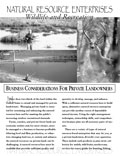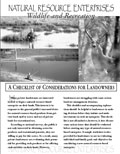Start a Business
Manage a Business
Business Types
Inventory Your Land
Before you begin planning for your business, you need to know what resources are readily available to you as well as what you will need to run the business. These include:
- Wildlife Habitat
- Wildlife Populations
- Domestic Animals
- Buildings
- Equipment
- Machinery
- Acres of Land
- Ponds or Lakes
- Existing Hazards
- Adjacent Land Use
Inventorying these resources will help you determine whether or not you can run a business on your land and what type of business types you can consider. It will help you determine not only what is lacking, but also what is underused on your land. Read "Business Considerations for Private Landowners" for more information.
Financial and Labor Resource Inventory
Financial and labor resources needed to run the business must also be considered. When considering your labor needs, ask yourself the following questions:
- How many employees will I need to operate the business effectively and efficiently?
- What types of employees do I need?
- What labor laws apply to my business?
- Will I need manual laborers, such as for landscape maintenance?
- Will my business need guides for tours and hunts or other customized personal service?
- Will I need employees with managerial, clerical, and bookkeeping skills?
- How easy/hard will it be to find the employees I am looking for in my area?
- What other businesses in the area may compete with me for employees or customers?
When considering labor resources, don't forget to include yourself and any family members that may be involved in the business.
An inventory of the financial resources should include:
- available capital
- outstanding loans on physical assets to be used in the business (land, buildings, equipment, etc.)
- opportunity costs (revenue you could have earned if you used the property for something else such as crops, timber production, or livestock)
- input costs
- risks costs
- cost of liability insurance (if needed)
Each inventory (physical, labor, and financial) should be included in your overall business plan. Read "Business Considerations for Private Landowners" for more information.

Business Considerations for Private Landowners (PDF)
Mississippi State University Extension Service
Mississippi State University Extension Service. The first step to planning a natural resource enterprise is writing up a business plan to determine if the business is realistic. Next, determine what physical, financial and labor recourses are available. Marketing, organizational and financial plans are necessary to determine if the business will succeed.

A Checklist of Considerations for Landowners (PDF)
Mississippi State University Extension Service
This is a list of things to consider before starting a natural resource enterprise. It includes the determining what resources are available, such as land and buildings and wildlife populations, determining if the land’s natural resources can be used for more than one purpose and if a sufficient labor force is available, liability insurance, how long the enterprise will last, the willingness of the family to participate in the enterprise, finding customers, the location of the business and how easy it is to access, and creating a business plan. A worksheet is provided to help evaluate the success of a potential natural resource enterprise.
Checklist for Starting a Value-Added Agriculture Enterprise (PDF)
NC State University
This checklist covers the areas to consider when researching the possibility of undertaking a value-added agricultural enterprise.

